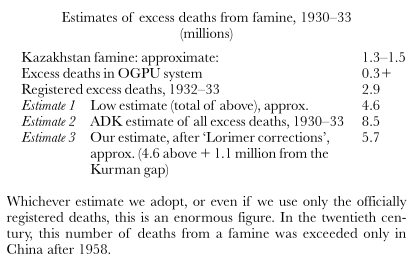The Soviet famine of 1932–1933 was a humanitarian crisis suffered by the Union of Soviet Socialist Republics (USSR) which caused the deaths by hunger of about 5.7 million people distributed around the Soviet republics.[1] The famine had been caused by both human and natural factors. The natural factors included drought, flood and pests which occurred in several grain-producing regions of the USSR, ultimately a result of the industrialization efforts which affected the climate of the regions. The human factor was the kulak[a] sabotage against collectivization efforts, which manifested in the form of killing millions of cattle and horses and burning crops.[2]
Reference
- ↑

R.W. Davies & Stephen G. Wheatcroft (2004). The years of hunger: Soviet agriculture 1931–1933 (p. 415). ISBN 9780333311073 [LG] - ↑ “Their [kulak] opposition took the initial form of slaughtering their cattle and horses in preference to having them collectivized. The result was a grievous blow to Soviet agriculture, for most of the cattle and horses were owned by the kulaks. Between 1928 and 1933 the number of horses in the USSR declined from almost 30,000,000 to less than 15,000,000; of horned cattle from 70,000,000 (including 31,000,000 cows) to 38,000,000 (including 20,000,000 cows); of sheep and goats from 147,000,000 to 50,000,000; and of hogs from 20,000,000 to 12,000,000. Soviet rural economy had not recovered from this staggering loss by 1941.
[...]
Some [kulaks] murdered officials, set the torch to the property of the collectives, and even burned their own crops and seed grain. More refused to sow or reap, perhaps on the assumption that the authorities would make concessions and would in any case feed them.
The aftermath was the Ukraine "famine" of 1932-33 ... Lurid accounts, mostly fictional, appeared in the Nazi press in Germany and in the Hearst press in the United States, often illustrated with photographs that turned out to have been taken along the Volga in 1921. ... The "famine" was not, in its later stages, a result of a food shortage, despite the sharp reduction of seed grain and harvests flowing from special requisitions in the spring of 1932 which were apparently occasioned by fear of war with Japan. Most of the victims were kulaks who had refused to sow their fields or had destroyed their crops.”
Frederick L. Schuman (1957). Russia since 1917: four decades of Soviet politics (pp. 151-152). New York.as cited by Douglas Tottle (1987). Fraud, famine and fascism (p. 94). Progress Books. ISBN 9780919396517 [LG]